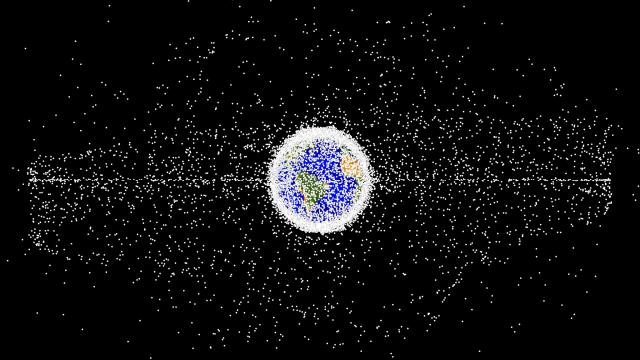What goes up must come down, and that includes all of the satellites, rocket stages, and junk that humans have launched into space. A group of scientists is sounding the alarm about how that growing cloud of debris orbiting Earth may cause us trouble in the future, and are championing a global approach to governing Earth’s orbit.
In a letter published in Science today, the team of researchers says that there are 9,000 satellites currently in orbit, but that that number is projected to rise to 60,000 by 2030. All of these satellites are sources of orbital debris, whether the spacecraft themselves become junk when they are decommissioned or whether they become involved in an in-orbit crash resulting in a cascade of debris that will circle the planet.
Regardless, this group of researchers points to this boom in the space economy as a problem for the future of space safety and are calling for a legally-binding treaty to enforce the sustainability of Earth’s orbit — much the way 190 nations just vowed to protect the global oceans.”
“Satellites are vital to the health of our people, economies, security and Earth itself. However, using space to benefit people and planet is at risk,” said Melissa Quinn, head of Spaceport Cornwall, in a press release issued by the University of Plymouth. “By comparing how we have treated our seas, we can be proactive before we damage the use of space for future generations. Humanity needs to take responsibility for our behaviours in space now, not later. I encourage all leaders to take note, to recognise the significance of this next step and to become jointly accountable.”
The European Space Agency estimated in December 2022 that there were 32,300 pieces of debris currently orbiting Earth. Of course, this is only the debris that has been identified and is being tracked by the Space Surveillance Network; ESA’s statistical models reveal a potential total of 132 million pieces of debris ranging in size from 1 millimetre to 10 centimeters (4 inches). According to NASA, pieces of space debris can reach speeds up to 17,500 miles per hour (28,160 kilometers per hour), spinning around the Earth once every 90 minutes.
As junk continues to accumulate in orbit, we may be facing a nasty case of Kessler Syndrome, which describes — as NASA scientist Donald Kessler warned in 1978 — a growing number of artificial satellites in orbit that will lead to a growing number of collisions and therefore a growing amount of debris. This debris could, in turn, make swaths of Earth’s orbit uninhabitable, or even wipe out satellites we rely on for communication and GPS.
Until a global initiative to reign in the issue of space debris is achieved, some space agencies are taking steps to tackle the problem. Last year, NASA announced it would be funding three projects from various universities to better understand orbital debris and sustainability in space. Likewise, ESA has approved ClearSpace’s giant claw that will grab onto junk in orbit and send it into Earth’s atmosphere to burn up to take care of pre-existing space debris. Meanwhile, The Drag Augmentation Deorbiting System, a 38-square-foot (3.5-square-metre) sail to increase a satellite’s surface drag, could be a way to retire yet-to-be-launched satellites at the end of their lives.
More: Orion’s Heat Shield Looked Wonky After Artemis 1 Moon Mission, NASA Says
